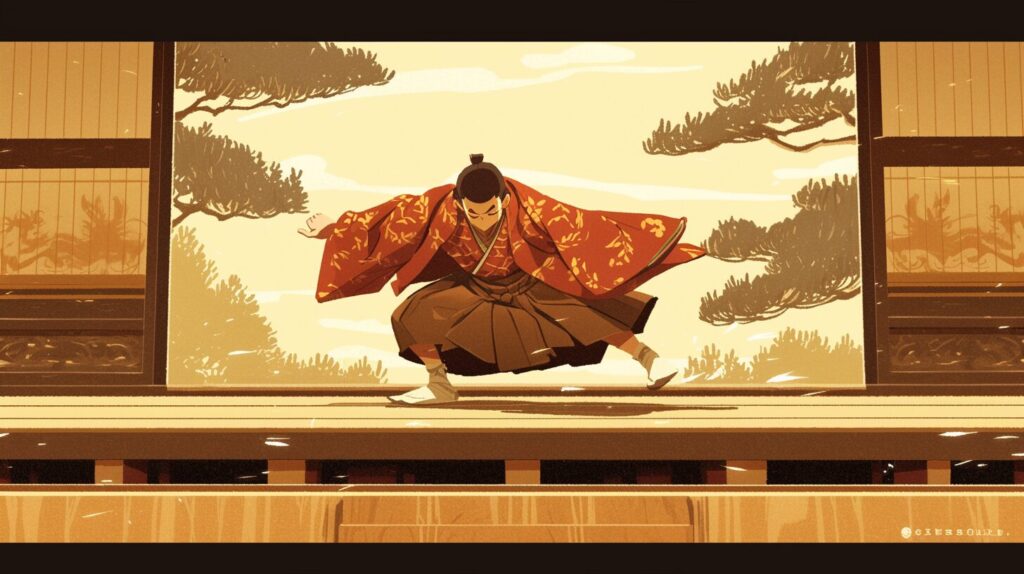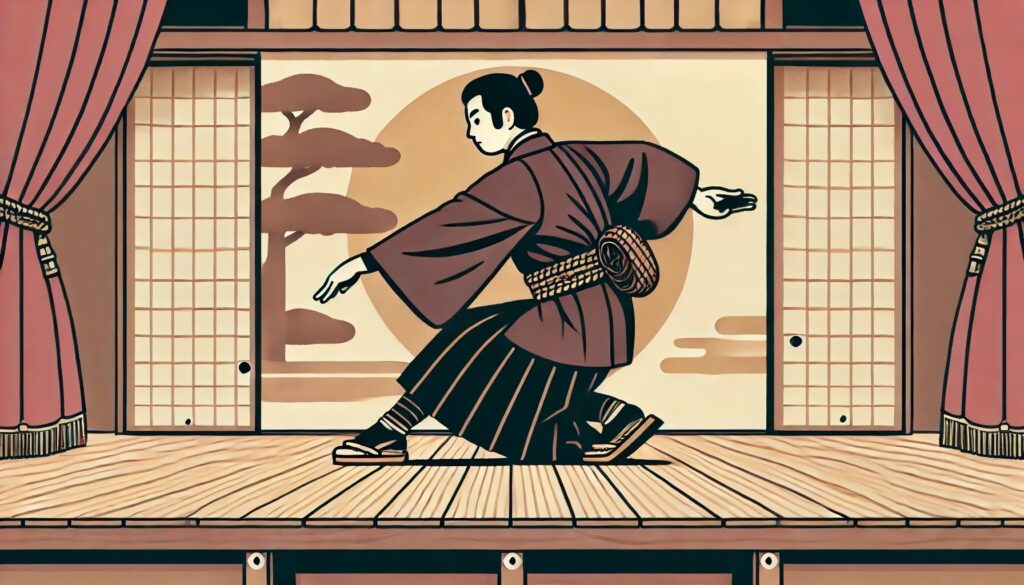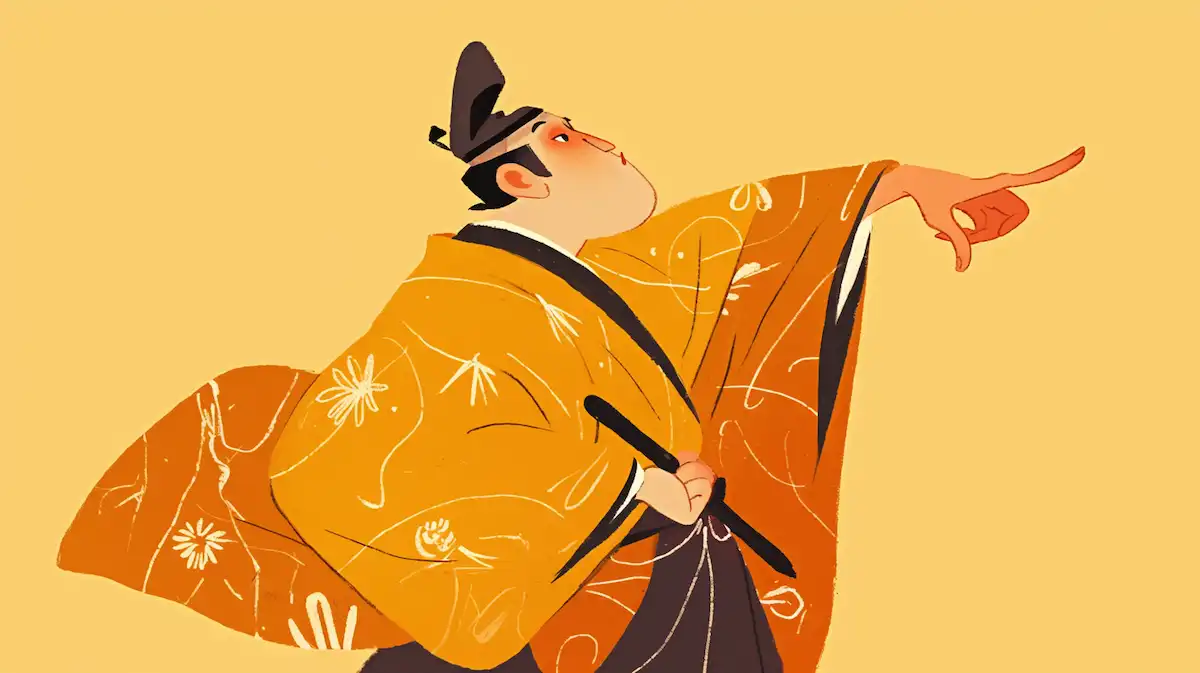狂言を英語で説明・紹介するための基本情報と、英会話に役立つ表現をシンプルでわかりやすい英語で紹介します。
英会話ダイアローグ・関連情報・10の質問を通して、狂言に関する英語表現を学びます。
英語
英会話ダイアローグを読む前に知っておくと良い前提知識と情報です。
- 狂言の基本情報
- 古典芸能の一つで、14世紀頃から続いている
- 能と共に発展、能が象徴的で厳粛なのに対し、狂言はユーモラスで現実的
- 日常生活や人間の弱さを題材にし、笑いを通じて観客を楽しませる
- 狂言の主要な特徴
- 簡単で面白いストーリーが特徴
- 例:「棒縛り」:召使いが主人に縛られても酒を飲む話
- 例:「附子」:毒だと思わせた砂糖をめぐるコメディ
- 台詞は分かりやすく、動きは誇張されていて面白さを強調
- マスク(面)は動物や精霊の役でのみ使用
- 初心者にも分かりやすく、笑いながら楽しむことが推奨
- 簡単で面白いストーリーが特徴
- 鑑賞のポイント
- 東京の「国立能楽堂」や「観世能楽堂」などで公演が見られる
- 初心者におすすめの演目は、「棒縛り」「附子」「柿山伏」など、シンプルで理解しやすい内容
- 伝統を守りつつ、現代のテーマや新しい表現を取り入れた公演も増えている
2人が狂言について話しています。
狂言の歴史、特徴、魅力、代表的な演目、鑑賞できる場所などについて話題にしています。
会話 / dialogue

Hey, Key. I’ve been living in Japan for a while now, and I’ve started getting curious about traditional arts. Have you heard of Kyogen?

Of course! Kyogen is one of Japan’s classical performing arts, similar to Noh. But it’s more humorous and focuses on everyday life. Are you interested in watching it?

Yeah, I’ve heard it’s funny and easier to understand than Noh. But I don’t know much about it. Can you tell me more?

Sure. Kyogen has been around since the Muromachi period, around the 14th century. It developed alongside Noh but has a very different style. While Noh is symbolic and serious, Kyogen is lighthearted and realistic.

That sounds fascinating. What kind of stories do they perform?

Most Kyogen plays are simple and comedic. They often show human weaknesses or funny misunderstandings. For example, in the play “Bōshibari”, two servants are tied up by their master to stop them from drinking his sake, but they still manage to drink it!

That’s hilarious! Are there any other famous plays?

Definitely. “Busu” is another popular one. The master leaves a jar of what he calls poison with his servant, but it’s actually sugar. The servant’s curiosity leads to funny trouble. There’s also “Kaki Yamabushi”, where a traveling priest steals persimmons and gets caught.

I love how these stories feel relatable, even though they’re centuries old. How do the actors perform these stories?

The actors use exaggerated movements and very clear dialogue. They don’t wear masks unless they’re playing animals or spirits. It’s all about timing, gestures, and the way they deliver their lines.

I see. Where can I watch Kyogen?

Tokyo has some great places. The National Noh Theatre in Sendagaya is a major venue. You can also check out the Kanze Noh Theatre in Ginza. Both host regular performances.

That’s good to know. What makes Kyogen so special compared to other traditional arts?

It’s the humor and simplicity. Kyogen doesn’t take itself too seriously, but it still reflects human nature. It’s easy for beginners to enjoy, and the exaggerated gestures make the stories clear, even if you don’t fully understand the language.

Sounds like the perfect introduction to Japanese traditional arts. Are there any modern adaptations of Kyogen?

Yes! Some performers blend traditional Kyogen with modern themes or collaborate with other art forms. It’s a great way to keep the tradition alive while appealing to new audiences.

I’d love to watch a performance. Do you think it’s okay to laugh during the show?

Absolutely! Laughing is part of the experience. Kyogen is meant to entertain, so don’t hold back.

Perfect. Thanks, Key. Let’s find a performance soon—I can’t wait to experience Kyogen firsthand!

Anytime, Mack. You’ll love it. Let me know when you’re ready to go.
関連情報 / related information
「狂言」について、理解を深めるための「英語での関連情報」です。
狂言

What is Kyogen?
Kyogen is a traditional Japanese performing art that focuses on humor and everyday life. It developed in the 14th century during the Muromachi period and is often performed together with Noh theater. While Noh is serious and symbolic, Kyogen is lighthearted and easy to understand. It uses comedy to explore human nature and simple, relatable stories.
The Style of Kyogen
Kyogen actors use clear speech, exaggerated movements, and precise timing to create humor. Unlike Noh, Kyogen performers usually do not wear masks, except when they play animals or spirits. The performances are based on dialogue, and the actors use gestures and facial expressions to make the stories entertaining. Even people who do not understand Japanese can enjoy Kyogen because the movements and expressions are so clear.
Famous Kyogen Stories
Kyogen has many simple and funny stories. One famous play is “Bōshibari” (Tied to a Stick), where two servants are tied up by their master to stop them from drinking his sake, but they still find a way to drink it. Another is “Busu” (The Poison Jar), where a servant is told that a jar contains poison, but it is actually sugar. His curiosity leads to a funny situation. These stories often show human weaknesses in a humorous way.
Where to Watch Kyogen
You can watch Kyogen in many theaters across Japan. In Tokyo, the National Noh Theatre in Sendagaya and the Kanze Noh Theatre in Ginza are popular places. These theaters regularly host Kyogen performances. Beginners can also enjoy special shows with explanations to help them understand the stories and traditions.
Why Kyogen is Special
Kyogen is special because it is both traditional and accessible. It has been performed for over 600 years, yet its humor and simple stories make it easy to enjoy, even today. It reflects human nature through comedy and offers a unique way to learn about Japanese culture. Kyogen is not only entertaining but also a great introduction to traditional Japanese arts.
10の質問 / 10 questions
「狂言」について、理解を深めるための「英語での10の質問」です。
1: What is Kyogen?
Kyogen is a traditional Japanese performing art that uses humor and simple stories to entertain audiences. It developed alongside Noh theater during the Muromachi period.
2: How is Kyogen different from Noh?
While Noh is serious, symbolic, and focused on spiritual themes, Kyogen is lighthearted, realistic, and focuses on everyday life and human nature.
3: What are Kyogen actors known for?
Kyogen actors are known for their clear speech, exaggerated movements, and precise timing, which make the performances entertaining and easy to understand.
4: Do Kyogen actors wear masks?
Kyogen actors usually perform without masks. However, they sometimes use masks when portraying animals or supernatural beings.
5: What is a famous Kyogen play?
One famous play is “Bōshibari,” where two servants are tied up by their master to stop them from drinking sake, but they cleverly find a way to drink it anyway.
6: Where can people watch Kyogen in Japan?
Kyogen can be seen in theaters like the National Noh Theatre in Sendagaya and the Kanze Noh Theatre in Ginza, Tokyo. These theaters hold regular performances.
7: What makes Kyogen stories appealing?
Kyogen stories are simple, funny, and relatable. They often highlight human weaknesses or misunderstandings in a humorous way.
8: How long has Kyogen been performed?
Kyogen has been performed for over 600 years, making it one of Japan’s oldest performing arts.
9: Can beginners enjoy Kyogen?
Yes, Kyogen is easy to enjoy for beginners because of its humor, clear dialogue, and exaggerated actions that make the stories understandable.
10: Why is Kyogen important today?
Kyogen is important because it preserves traditional Japanese culture while remaining accessible and entertaining. It also reflects timeless human nature through comedy.

和訳付
会話 / dialogue

Hey, Key. I’ve been living in Japan for a while now, and I’ve started getting curious about traditional arts. Have you heard of Kyogen?
ねえ、キー。日本に住んでしばらく経つんだけど、最近伝統芸能に興味が出てきてさ。狂言って聞いたことある?

Of course! Kyogen is one of Japan’s classical performing arts, similar to Noh. But it’s more humorous and focuses on everyday life. Are you interested in watching it?
もちろん!狂言は日本の伝統的な舞台芸術の一つで、能に似てるけど、もっとユーモラスで日常生活に焦点を当てているんだよ。観てみたい?

Yeah, I’ve heard it’s funny and easier to understand than Noh. But I don’t know much about it. Can you tell me more?
うん、能より面白くてわかりやすいって聞いたことがあるけど、あまり詳しくないんだ。もっと教えてくれる?

Sure. Kyogen has been around since the Muromachi period, around the 14th century. It developed alongside Noh but has a very different style. While Noh is symbolic and serious, Kyogen is lighthearted and realistic.
いいよ。狂言は室町時代、14世紀頃から続いていて、能と一緒に発展したんだ。でもスタイルが全然違うんだよ。能が象徴的で厳かなのに対して、狂言は軽快で現実的なんだ。

That sounds fascinating. What kind of stories do they perform?
面白そうだね。どんな話が演じられるの?

Most Kyogen plays are simple and comedic. They often show human weaknesses or funny misunderstandings. For example, in the play “Bōshibari”, two servants are tied up by their master to stop them from drinking his sake, but they still manage to drink it!
多くの狂言の演目はシンプルでコミカルだよ。人間の弱さや面白い誤解を描いていることが多いね。たとえば「棒縛り」では、主人が酒を飲ませないように召使いを縛るんだけど、それでも二人は飲んでしまうんだ。

That’s hilarious! Are there any other famous plays?
それ、めちゃくちゃ面白いね!他にも有名な演目ってある?

Definitely. “Busu” is another popular one. The master leaves a jar of what he calls poison with his servant, but it’s actually sugar. The servant’s curiosity leads to funny trouble. There’s also “Kaki Yamabushi”, where a traveling priest steals persimmons and gets caught.
もちろん。「附子」も有名だよ。主人が毒だと言って壺を召使いに預けるんだけど、それは実は砂糖で、召使いが好奇心で食べちゃうんだ。それから「柿山伏」では、旅の僧侶が柿を盗んで捕まる話だね。

I love how these stories feel relatable, even though they’re centuries old. How do the actors perform these stories?
そういう話って、何百年も前のものなのに共感できるのがいいね。役者たちはどうやって演じるの?

The actors use exaggerated movements and very clear dialogue. They don’t wear masks unless they’re playing animals or spirits. It’s all about timing, gestures, and the way they deliver their lines.
役者たちは誇張された動きと、はっきりした台詞を使って演じるよ。動物や精霊を演じるとき以外は面をつけないんだ。タイミングや身振り、台詞の言い方が重要なんだよ。

I see. Where can I watch Kyogen?
なるほど。どこで狂言を観られるの?

Tokyo has some great places. The National Noh Theatre in Sendagaya is a major venue. You can also check out the Kanze Noh Theatre in Ginza. Both host regular performances.
東京にはいくつか良い場所があるよ。千駄ヶ谷の国立能楽堂は主要な会場だし、銀座の観世能楽堂もいいね。どちらも定期的に公演をやっているよ。

That’s good to know. What makes Kyogen so special compared to other traditional arts?
いいこと聞いた。他の伝統芸能と比べて、狂言の特別なところって何?

It’s the humor and simplicity. Kyogen doesn’t take itself too seriously, but it still reflects human nature. It’s easy for beginners to enjoy, and the exaggerated gestures make the stories clear, even if you don’t fully understand the language.
ユーモアとシンプルさだね。狂言は肩肘張らないけど、それでも人間の本質を映し出しているんだ。初心者にも楽しみやすいし、誇張された動きのおかげで、言葉が全部わからなくても話が伝わるよ。

Sounds like the perfect introduction to Japanese traditional arts. Are there any modern adaptations of Kyogen?
日本の伝統芸能を知るのにピッタリだね。狂言の現代的なアレンジってあるの?

Yes! Some performers blend traditional Kyogen with modern themes or collaborate with other art forms. It’s a great way to keep the tradition alive while appealing to new audiences.
あるよ!伝統的な狂言に現代のテーマを取り入れたり、他の芸術とコラボレーションすることもあるんだ。それによって伝統を守りながら新しい観客層にアピールできるんだよ。

I’d love to watch a performance. Do you think it’s okay to laugh during the show?
公演を観てみたいな。公演中に笑っても大丈夫だと思う?

Absolutely! Laughing is part of the experience. Kyogen is meant to entertain, so don’t hold back.
もちろん!笑うのも体験の一部だよ。狂言は楽しむためのものだから、遠慮しなくていいんだ。

Perfect. Thanks, Key. Let’s find a performance soon—I can’t wait to experience Kyogen firsthand!
完璧だね。ありがとう、キー。早速公演を探そうよ。直接狂言を体験するのが待ちきれない!

Anytime, Mack. You’ll love it. Let me know when you’re ready to go.
いつでもいいよ、マック。きっと気に入ると思う。行く準備ができたら教えてね。
関連情報 / related information
狂言

What is Kyogen?
Kyogen is a traditional Japanese performing art that focuses on humor and everyday life. It developed in the 14th century during the Muromachi period and is often performed together with Noh theater. While Noh is serious and symbolic, Kyogen is lighthearted and easy to understand. It uses comedy to explore human nature and simple, relatable stories.
狂言とは?
狂言はユーモアや日常生活をテーマにした日本の伝統的な舞台芸術です。14世紀の室町時代に発展し、能と一緒に上演されることがよくあります。能が厳粛で象徴的であるのに対し、狂言は軽快でわかりやすい内容が特徴です。人間性や共感できる物語をコメディとして描きます。
The Style of Kyogen
Kyogen actors use clear speech, exaggerated movements, and precise timing to create humor. Unlike Noh, Kyogen performers usually do not wear masks, except when they play animals or spirits. The performances are based on dialogue, and the actors use gestures and facial expressions to make the stories entertaining. Even people who do not understand Japanese can enjoy Kyogen because the movements and expressions are so clear.
狂言のスタイル
狂言の役者は、明瞭な発声、誇張された動き、正確なタイミングを使って笑いを生み出します。能とは異なり、動物や精霊を演じる場合を除いて、通常は面をつけません。演技は台詞を中心に展開し、ジェスチャーや表情を用いて物語を楽しませます。日本語がわからない人でも、動きや表現がとても分かりやすいため、狂言を楽しむことができます。
Famous Kyogen Stories
Kyogen has many simple and funny stories. One famous play is “Bōshibari” (Tied to a Stick), where two servants are tied up by their master to stop them from drinking his sake, but they still find a way to drink it. Another is “Busu” (The Poison Jar), where a servant is told that a jar contains poison, but it is actually sugar. His curiosity leads to a funny situation. These stories often show human weaknesses in a humorous way.
有名な狂言の演目
狂言には多くのシンプルで面白い物語があります。有名な演目の一つに「棒縛り」があり、主人が酒を飲ませないために召使いを縛るのですが、彼らはそれでも酒を飲む方法を見つけます。また「附子」では、壺に毒が入っていると言われた召使いが、実はそれが砂糖だと知り、好奇心から面白いトラブルに巻き込まれる物語です。これらの物語は、ユーモアを通じて人間の弱さを描いています。
Where to Watch Kyogen
You can watch Kyogen in many theaters across Japan. In Tokyo, the National Noh Theatre in Sendagaya and the Kanze Noh Theatre in Ginza are popular places. These theaters regularly host Kyogen performances. Beginners can also enjoy special shows with explanations to help them understand the stories and traditions.
狂言を鑑賞できる場所
狂言は日本各地の多くの劇場で鑑賞できます。東京では、千駄ヶ谷にある国立能楽堂や銀座の観世能楽堂が人気の場所です。これらの劇場では、定期的に狂言の公演が行われています。初心者向けの解説付き公演もあり、物語や伝統を理解しやすい工夫がされています。
Why Kyogen is Special
Kyogen is special because it is both traditional and accessible. It has been performed for over 600 years, yet its humor and simple stories make it easy to enjoy, even today. It reflects human nature through comedy and offers a unique way to learn about Japanese culture. Kyogen is not only entertaining but also a great introduction to traditional Japanese arts.
狂言の特別な魅力
狂言が特別なのは、伝統的でありながら親しみやすい点にあります。600年以上も演じられてきましたが、そのユーモアとシンプルな物語は現代でも楽しみやすいものです。狂言はコメディを通じて人間性を映し出し、日本文化を学ぶ独特の方法を提供します。狂言はただ楽しいだけでなく、日本の伝統芸能を知るための素晴らしい入口でもあります。
10の質問 / 10 questions
1: What is Kyogen?
狂言とは何ですか?
Kyogen is a traditional Japanese performing art that uses humor and simple stories to entertain audiences. It developed alongside Noh theater during the Muromachi period.
狂言は、ユーモアとシンプルな物語を使って観客を楽しませる日本の伝統的な舞台芸術です。室町時代に能とともに発展しました。
2: How is Kyogen different from Noh?
狂言は能とどう違いますか?
While Noh is serious, symbolic, and focused on spiritual themes, Kyogen is lighthearted, realistic, and focuses on everyday life and human nature.
能が厳粛で象徴的、そして精神的なテーマに焦点を当てているのに対し、狂言は軽快で現実的で、日常生活や人間性に焦点を当てています。
3: What are Kyogen actors known for?
狂言の役者は何で知られていますか?
Kyogen actors are known for their clear speech, exaggerated movements, and precise timing, which make the performances entertaining and easy to understand.
狂言の役者は、明瞭な発声、誇張された動き、正確なタイミングで知られています。これにより、演技は楽しくわかりやすいものになっています。
4: Do Kyogen actors wear masks?
狂言の役者は面をつけますか?
Kyogen actors usually perform without masks. However, they sometimes use masks when portraying animals or supernatural beings.
狂言の役者は通常、面をつけずに演じます。しかし、動物や超自然的な存在を演じるときには、面を使用することがあります。
5: What is a famous Kyogen play?
有名な狂言の演目は何ですか?
One famous play is “Bōshibari,” where two servants are tied up by their master to stop them from drinking sake, but they cleverly find a way to drink it anyway.
「棒縛り」という有名な演目があります。召使い二人が主人に縛られて酒を飲めないようにされますが、賢くも何とかして酒を飲む方法を見つける物語です。
6: Where can people watch Kyogen in Japan?
日本ではどこで狂言を見ることができますか?
Kyogen can be seen in theaters like the National Noh Theatre in Sendagaya and the Kanze Noh Theatre in Ginza, Tokyo. These theaters hold regular performances.
狂言は、千駄ヶ谷の国立能楽堂や銀座の観世能楽堂などの劇場で見ることができます。これらの劇場では定期的に公演が行われています。
7: What makes Kyogen stories appealing?
狂言の物語が魅力的な理由は何ですか?
Kyogen stories are simple, funny, and relatable. They often highlight human weaknesses or misunderstandings in a humorous way.
狂言の物語はシンプルで面白く、共感できるものです。人間の弱さや誤解をユーモラスに描くことが多いです。
8: How long has Kyogen been performed?
狂言はどれくらいの間演じられていますか?
Kyogen has been performed for over 600 years, making it one of Japan’s oldest performing arts.
狂言は600年以上にわたって演じられており、日本最古の舞台芸術の一つです。
9: Can beginners enjoy Kyogen?
初心者でも狂言を楽しめますか?
Yes, Kyogen is easy to enjoy for beginners because of its humor, clear dialogue, and exaggerated actions that make the stories understandable.
はい、狂言はユーモアや明瞭な台詞、誇張された動きのおかげで初心者にも楽しみやすいです。
10: Why is Kyogen important today?
狂言は現代でなぜ重要なのですか?
Kyogen is important because it preserves traditional Japanese culture while remaining accessible and entertaining. It also reflects timeless human nature through comedy.
狂言は、日本の伝統文化を守りながら、親しみやすく楽しめる点で重要です。また、コメディを通じて普遍的な人間性を映し出しています。

words & phrases
英会話ダイアローグと関連情報に出てきた単語・フレーズです(例文は各3つ)。

lighthearted : 形容詞
意味: 気軽な、楽しい。Not serious, cheerful, or free from worry.
(狂言が軽快で現実的なスタイルを持っていることを指している)
例文:
- The movie was a lighthearted comedy perfect for a weekend evening.
「その映画は週末の夜にぴったりの気軽なコメディでした。」 - She gave a lighthearted laugh at the joke.
「彼女はその冗談に気軽に笑った。」 - The conversation was lighthearted, with no serious topics.
「会話は気軽で、深刻な話題はありませんでした。」
comedic : 形容詞
意味: コメディ的な、笑いを生む。Relating to or characteristic of comedy.
(狂言の物語がユーモアに満ちた内容であることを指している)
例文:
- The play had great comedic timing, making the audience laugh constantly.
「その劇は素晴らしいコメディ的なタイミングで、観客を笑わせ続けました。」 - His comedic talent was evident in his performance.
「彼のコメディ的な才能は演技に明らかでした。」 - The show’s comedic elements appealed to a wide audience.
「そのショーのコメディ的要素は幅広い観客に好まれました。」
hilarious : 形容詞
意味: 非常に面白い、爆笑するほど。Extremely funny or amusing.
(「棒縛り」などの狂言のエピソードが非常に面白いと感じられる点を指している)
例文:
- The comedian’s jokes were absolutely hilarious.
「そのコメディアンのジョークは爆笑するほど面白かった。」 - We had a hilarious time watching the Kyogen play.
「狂言を観ながら非常に楽しい時間を過ごしました。」 - That was the most hilarious story I’ve ever heard.
「それは私がこれまで聞いた中で最も面白い話でした。」
relatable : 形容詞
意味: 共感できる、親しみやすい。Able to be understood or felt in a way that is familiar or relevant.
(狂言の物語が現代でも共感できる内容であることを指している)
例文:
- The Kyogen play had a very relatable theme about human nature.
「狂言の演目は人間性について非常に共感できるテーマを持っていました。」 - Her story was so relatable that everyone in the room laughed.
「彼女の話はとても共感できる内容で、部屋の全員が笑いました。」 - The movie’s characters were realistic and relatable.
「その映画のキャラクターは現実的で共感できました。」
adaptation : 名詞
意味: 適応、改作。A version of something that has been changed or adjusted for a new purpose or audience.
(狂言が現代的なテーマを取り入れるなど、伝統を守りつつ進化している点を指している)
例文:
- The play is a modern adaptation of a classic Kyogen story.
「その劇は狂言の古典的な物語の現代的な改作です。」 - The book’s adaptation into a film was very successful.
「その本の映画化は非常に成功しました。」 - His work shows a unique adaptation of traditional and modern styles.
「彼の作品は伝統と現代のスタイルの独自の適応を示しています。」
